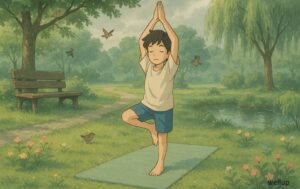In today’s busy world, stress has become a normal part of life. We feel it when deadlines build up, when our phone keeps buzzing with messages, or when unexpected problems suddenly appear. Sometimes the day hasn’t even started, yet our mind already feels tired.
But what if there was an ancient way of thinking that could help you reduce daily stress, stay calm, focused, and strong—no matter what life throws at you?
That way of thinking is Stoicism. Born in ancient Greece over 2,000 years ago, Stoicism has been followed by wise thinkers, great leaders, and even Roman emperors. It teaches simple but powerful ways to stay steady in difficult times and to focus on what truly matters.
One of the most famous Stoics, Marcus Aurelius, once wrote: “You have power over your mind – not outside events. Realize this, and you will find strength” [1]Meditations, Book 8. This simple idea reminds us that while we can’t control everything that happens, we can control how we think and respond.
Whether you’re facing work stress, personal challenges, or the daily chaos of modern life, Stoicism can help you handle it all with clarity and confidence. In this guide, you’ll learn how Stoicism works, discover 5 practical Stoic techniques you can start using today to relieve your stress, and see why this ancient wisdom is still one of the best tools for daily stress relief in our fast-paced world.
Understanding Stoicism and Its Core Philosophy
Stoicism is an ancient Greek philosophy founded in the early 3rd century BCE by Zeno of Citium [2]Zeno of Citium Biography. It later flourished in Rome, influencing great thinkers like Seneca, Epictetus, and Marcus Aurelius. While often associated with emotionless endurance, Stoicism is not about suppressing feelings—it’s about understanding them and responding with reason rather than impulse.
At its heart, Stoicism for stress is built on the idea that we can’t control external events, but we can control our judgments, attitudes, and actions. This principle is famously expressed in what’s called the Dichotomy of Control:
“Some things are up to us, and some things are not.” — Epictetus [3]Enchiridion, Chapter 1.
The Stoic path to calm and resilience rests on three main pillars:
- Focus on what you can control – Let go of worries about outcomes beyond your influence.
- Live in harmony with nature and reason – Align your choices with virtue, wisdom, and justice.
- Reframe adversity as opportunity – See challenges as a way to strengthen your character.
By adopting these principles, Stoics turn life’s uncertainties into training grounds for inner peace. This mindset not only reduces stress but also fosters a deep sense of stability—even in chaotic situations.
How Stoicism Reframes Stress for Daily Relief
Most people view stress as something that happens to them—a reaction to difficult people, tight deadlines, or unexpected problems. Stoic stress management takes a different approach: it teaches that stress is not caused by events themselves but by our judgment of those events. As Epictetus wrote, “Men are disturbed not by things, but by the view which they take of them” [4]Enchiridion, Chapter 5.
This perspective is surprisingly modern. Cognitive Behavioral Therapy (CBT), one of today’s most effective psychological treatments for anxiety and stress, is directly influenced by Stoic philosophy [5]The philosophical origins of CBT. Both emphasize that we can’t always control what happens, but we can control how we interpret and respond to it.
In stoic strategies for daily stress relief, the goal is to shift your mindset from reactive to reflective:
- Instead of thinking “This is a disaster,” you might think “This is challenging, but I can handle it.”
- Rather than blaming circumstances, you focus on your choices in the present moment.
By reframing stress as a signal to exercise reason, patience, and resilience, Stoicism turns life’s pressures into opportunities for personal growth. This shift not only reduces the emotional weight of stress but also helps you approach challenges with calm, steady determination.
5 Practical Stoic Techniques for Daily Stress Relief
While the philosophy of Stoicism offers profound wisdom, its real power lies in application. You don’t need to become a scholar of ancient texts to benefit; just a few practical techniques can help you face daily challenges and stress with greater calm and clarity.
Below are five time-tested Stoic practices that you can start using today to reduce stress, sharpen focus, and build emotional resilience—no matter what life throws at you.
1. Negative Visualization (Premeditatio Malorum)
At first glance, imagining bad things might sound like a recipe for more stress, not less. But the Stoics saw it differently. Known in Latin as Premeditatio Malorum (“the premeditation of evils”), this practice involves mentally preparing for possible setbacks before they happen—not to make yourself miserable, but to become less vulnerable to shock and disappointment.
The Stoic philosopher Seneca wrote, “The unexpected blows are the ones that crush us. It is better to rehearse misfortunes than to fall into them unprepared” [6]Letters to Lucilius, Letter 91. His point was simple: when life’s challenges arrive, they hurt less if we’ve already met them in our minds.
In practice, negative visualization works by gently picturing realistic obstacles you might face—a delayed train, a project going off track, a difficult conversation—and then imagining how you would respond calmly and wisely. This mental rehearsal builds resilience, much like a fire drill prepares you for an actual emergency.
Modern psychology backs this up. A study on “defensive pessimism” found that anticipating possible problems can actually lower anxiety, because it helps people develop strategies in advance [7]Norem & Cantor, Defensive Pessimism. In other words, by imagining what could go wrong, you take away its power to overwhelm you.
Here’s how it might look in daily life:
Before an important presentation, you might picture the slides failing to load. In your mind, you calmly continue speaking, relying on your notes. You imagine a tough question from the audience and yourself answering with honesty, even if you don’t have all the details. By the time you actually walk into the room, you’re ready for both the best and the worst.
The key is balance. This isn’t about dwelling on disasters or spiraling into “what if” thinking. Negative visualization works best when you keep scenarios realistic, short, and always paired with a plan for how you’ll respond. As the Stoics would say, the goal is not to fear the storm, but to know you can steer through it.
2. The Dichotomy of Control
If there’s one idea at the heart of Stoicism, it’s this: some things are up to us, and some things are not. This is known as the Dichotomy of Control, a principle introduced by the Stoic philosopher Epictetus in his Enchiridion: “Some things are in our control and others not. Things in our control are opinion, pursuit, desire, aversion, and, in a word, whatever are our own actions. Things not in our control are body, property, reputation, command, and, in a word, whatever is not our own actions” [3]Enchiridion, Chapter 1.
The logic is simple but profound. Stress often comes from trying to control the uncontrollable—worrying about other people’s opinions, obsessing over the outcome of events, or trying to change circumstances that are already set in motion. The Stoic approach flips this on its head: invest your energy only in what you can influence, and accept the rest with equanimity.
For example, imagine you’ve applied for a job. You can control how well you prepare for the interview—your research, your punctuality, your communication. But once the interview is over, the hiring decision lies beyond your control. Spending sleepless nights worrying about whether they’ll call back won’t help. Instead, a Stoic would shift focus to the next action they can take—perhaps preparing for another opportunity—freeing themselves from unnecessary mental strain.
Modern psychology supports this mindset. Studies show that focusing on factors within our control is linked to higher resilience and lower anxiety [8]Thompson, Control Beliefs and Well-Being. In a way, the Dichotomy of Control is an ancient version of today’s “focus on what you can change” advice, but with deeper philosophical grounding.
By practicing this principle daily, you create a mental filter:
- Can I control this? If yes, act with clarity.
- Is this beyond my control? If yes, accept and adapt.
This doesn’t mean becoming passive. The Stoics were active citizens, leaders, and thinkers. The difference is that they acted where their efforts mattered most and refused to waste energy on things they couldn’t alter. The result? Less frustration, more focus, and a steadier mind in the face of uncertainty.
3. Memento Mori & Mindfulness
Few Stoic ideas are as striking—and as misunderstood—as Memento Mori, which means “Remember you must die.” At first, it sounds morbid, but for the Stoics, it was the opposite: a reminder to live fully, appreciate the present, and stop wasting time on trivial worries. As Marcus Aurelius wrote in Meditations: “You could leave life right now. Let that determine what you do and say and think” [9]Meditations, Book 2.
For stress relief, this idea works in a subtle but powerful way. When you remember that life is finite, the urgency of petty annoyances fades. The argument with a coworker, the traffic jam, the rude stranger—these begin to feel small in the bigger picture. Instead of spiraling into irritation, you refocus on what truly matters and handle the moment with perspective.
Mindfulness, in this Stoic sense, is not about sitting cross-legged and emptying your mind (though meditation can help). It’s about being fully engaged in what you’re doing right now—whether you’re talking to a friend, working on a task, or simply taking a walk. The Stoics practiced this by constantly bringing their attention back to the present moment, avoiding the trap of replaying the past or fearing the future.
Here’s how the two work together:
- Memento Mori gives you perspective: it reminds you that time is precious and finite.
- Mindfulness makes that perspective practical: it teaches you to use each moment well, without letting it be hijacked by stress or distraction.
Modern research backs this up. Studies on mortality awareness show it can increase gratitude and encourage people to live more intentionally [10]Cozzolino et al., Mortality Salience and Gratitude. Similarly, mindfulness-based interventions have been found to significantly reduce stress and anxiety by training attention to stay in the present [11]Khoury et al., Mindfulness-based therapy: A comprehensive meta-analysis.
A simple Stoic exercise is to start your day by acknowledging life’s fragility—without fear, just awareness—and then asking: “If this were my last day, how would I want to spend it?” This question naturally guides you toward priorities that matter and away from stress over things that don’t.
4. Stoic Journaling
For the Stoics, writing wasn’t just a way to record events—it was a tool for shaping the mind. Marcus Aurelius’s Meditations is essentially a private journal, never intended for publication, where he reflected on his thoughts, reminded himself of Stoic principles, and prepared for the challenges ahead [12]Meditations Overview. Likewise, Seneca’s letters to Lucilius are full of self-examination and philosophical advice, many of which were written as a way to clarify his own thinking.
Stoic journaling serves two main purposes for stress relief:
- Clearing mental clutter – Putting your worries, frustrations, and fears on paper often makes them feel less overwhelming.
- Reinforcing perspective – Writing about events from a Stoic point of view helps you reinterpret them in a calmer, more constructive way.
A typical Stoic journaling routine involves two sessions:
Morning preparation – Before the day begins, you might write about possible challenges and how you intend to face them. This echoes Marcus Aurelius’s habit of anticipating the day’s difficulties so they wouldn’t catch him off guard: “When you wake up in the morning, tell yourself: The people I deal with today will be meddling, ungrateful, arrogant…” [9]Meditations, Book 2.
Evening reflection – At night, review your day. Where did you handle stress well? Where did you let frustration win? The Stoic philosopher Epictetus advised self-examination each night, asking: “What did I do well? What did I do badly? What duty’s left undone?” [13]Discourses, Book 3.
Modern research supports this habit. Journaling has been shown to reduce stress, improve mood, and even boost problem-solving skills [14]Pennebaker, Writing to Heal. By combining this therapeutic effect with Stoic philosophy, you create a practice that not only releases tension but also trains your mind to respond wisely under pressure.
To start, all you need is a notebook and five minutes in the morning and evening. Over time, you’ll notice patterns—recurring stress triggers, unhelpful thought loops, and also the progress you’re making in staying calm. In this way, the journal becomes a personal guide, showing you not only where you’ve been, but also where you want to go.
5. Voluntary Discomfort
One of the more surprising Stoic practices is Voluntary Discomfort—deliberately choosing short periods of mild hardship to strengthen both body and mind. Seneca famously recommended occasionally living “as if” you had lost your wealth, wearing rough clothing, eating simple meals, and asking yourself: “Is this the condition I feared?” [15]Seneca, Letter 18: On Festivals and Fasting.
The idea is simple but profound: by experiencing discomfort on purpose, you reduce your fear of it. This has two stress-reducing effects:
- You build resilience – Small, chosen challenges prepare you for bigger, unchosen ones.
- You lessen attachment – You realize that comfort, wealth, or convenience are nice, but not essential for your peace of mind.
Examples of voluntary discomfort in daily life:
- Taking a cold shower instead of a hot one.
- Walking instead of using transport, even if it’s less convenient.
- Eating a plain, simple meal instead of your usual favorites.
- Leaving your phone at home for a day to embrace digital discomfort.
These practices aren’t about self-punishment. They’re about training yourself to stay calm and functional when circumstances aren’t perfect. That way, when real-life discomforts inevitably arise—flight delays, financial stress, sudden changes—you’re already mentally conditioned to handle them.
Modern psychology echoes this Stoic wisdom. Exposure therapy, for example, uses gradual, controlled exposure to feared situations to reduce anxiety responses [16]American Psychological Association: Exposure Therapy. Similarly, research on resilience training shows that intentional challenges can increase adaptability and emotional regulation [17]Southwick & Charney, Resilience: The Science of Mastering Life's Greatest Challenges.
If you begin practicing voluntary discomfort once or twice a week, you’ll notice a shift: situations that used to stress you will feel less threatening, because you’ve already faced something similar—by choice.
Integrating Stoicism Into Your Daily Routine
Learning Stoic principles is only half the journey—the real transformation comes when you live them daily. The Stoics didn’t treat philosophy as abstract theory; they saw it as a way of life, a constant practice of aligning thoughts, emotions, and actions with reason.
Here’s how you can make Stoicism a natural part of your everyday routine for long-term stress relief:
1. Start Your Morning with a Stoic Mindset
Before diving into the day, take 5–10 minutes to reflect on potential challenges you might face and how you can respond calmly. This “premeditation of evils” (premeditatio malorum) is inspired by Marcus Aurelius’s habit of preparing his mind each morning [9]Meditations, Book 2. It sets a tone of resilience before stress can take hold.
2. Use Stoic Reminders Throughout the Day
Keep a few short Stoic quotes or affirmations on your phone, desk, or notebook. For example: “You have power over your mind—not outside events. Realize this, and you will find strength” (Marcus Aurelius). Such reminders act as quick mental resets when stress builds.
3. Practice Mindful Pauses
When you notice frustration rising, take a short breath and ask yourself: “Is this within my control?” This is the Dichotomy of Control in action—reminding you to focus your energy only where it matters [18]Epictetus, Enchiridion.
4. Journal for Reflection and Growth
Spend 5–10 minutes in the evening writing down what went well, what could have gone better, and how you can approach tomorrow differently. Over time, you’ll see patterns in your stress responses and learn how to handle them more effectively.
5. Schedule Voluntary Discomfort
Once or twice a week, add a small challenge to your day—walk in the rain without an umbrella, skip your morning coffee, or take a cold shower. By embracing discomfort in controlled doses, you reduce the anxiety that comes when life forces discomfort upon you.
6. Close Your Day with Gratitude
End your night by listing three things you’re grateful for. While not explicitly Stoic, gratitude aligns perfectly with Stoic values—it helps shift focus from what’s lacking to what’s already present and sufficient. Research shows that gratitude can lower stress and improve emotional well-being [19]Harvard Health Publishing: Giving Thanks Can Make You Happier.
By weaving these small habits into your day, Stoicism becomes less of a “philosophy you study” and more of a “compass you live by.” Over time, these routines will help you face daily challenges with greater composure, turning stress into a teacher rather than an enemy.
Takeaways
In a world that constantly demands our attention, perfection, and productivity, stress has become almost unavoidable. Yet, as the Stoics taught over two thousand years ago, peace of mind is never truly determined by the chaos around us—it is shaped by how we choose to perceive and respond to it.
By applying practices like Negative Visualization, the Dichotomy of Control, Memento Mori, Stoic Journaling, and Voluntary Discomfort, you train your mind to focus on what matters, accept what cannot be changed, and stay calm under pressure.
Stoicism isn’t about suppressing emotions or becoming indifferent to life—it’s about cultivating resilience, clarity, and purpose, even in difficult moments. When integrated into daily life, its principles can transform stress from something that overwhelms you into something that strengthens you.
As Marcus Aurelius wrote: “If you are distressed by anything external, the pain is not due to the thing itself, but to your estimate of it—and this you have the power to revoke at any moment” [20]Marcus Aurelius's Meditations, Book 8.
Start small. Choose one Stoic technique to practice today. Over time, these ancient lessons will help you not just reduce daily stress, but live with a deeper sense of balance and meaning.
Read Next: 5 Life-Changing Stoic Quotes To Reshape Your Thinking










